 |
||
|
||
| ||
Intel has announced its flagship for the market of business and home PCs - the i815 chipset and its modifications - quite a long time ago. The prices are gradually falling down, the developers are running in an optimal design of a PCB for boards on it and increase the number of modifications. And at last the solutions on this plastform have transferred into the category of mass systems. Let's see what the market offers today among i815 boards. After an unsuccessful release of a series of i8xx chipsets in the beginning of 1999 Intel has at last launched a product which outscores competitors in the characteristics and now can go on a par with the i440BX. It is the i815 chipset and its modifications. Today it is the most popular chipset for the Socket 370 platform. A lot of manufacturers have been announcing boards on it. It is resulted in appearing of a great deal of mainboard models based on the i815x series. That is why today we will try to give you recommendations how to choose the right board for you. First of all, let's look at the i815 chipset itself and find out what modifications exist today. Basic possibilities of the i815xx series
As you can see, the chipset supports the whole set of the latest standards, unlike the i440BX, and works with usual SDRAM. Today there are four versions of this logic set: 815, 815E, 815EP, 815P. i815 -- the first chipset of this series. It includes a north bridge (GMCH -- Graphics and Memory Controller Hub) with integrated video (i752 graphics core), but without a display cache (which can be installed in an AGP slot as a Graphics Performance Accelerator). The 82801AA south bridge (known as ICH -- Input/Output Controller Hub) supports ATA33/66 modes and 2 USB ports. i815E -- the only difference from the i815 is in the ICH2 (82801BA), which supports up to ATA/100 modes and 4 USB-ports. i815EP -- the first version of the chipset without integrated video. It also contains the ICH2. i815P -- lacks for integrated video as well, but unlike the 815EP, it has ICH (ATA/66 and 2 USB-ports). Now let me compare the i815 with its closest competitor - VIA Apollo Pro 133A. As you can see from the table, the i815x looks rather attractive as compared with the VIA Apollo Pro 133A. But not everything is so brilliant:
Comparison table of chipsets' characteristics
While the first two items do not play a vital role in business and home computers, the incomplete asynchronism shaves off the performance. You may ask us why we do not compare the i815 with the latest chipsets from VIA and SIS which support DDR SDRAM. First, such comparison is not correct due to a big difference in the cost of finished solutions on these platforms. Secondly, because of the AGTL+ bus, usage of the DDR SDRAM doesn't make any sense. Since the processor can process one packet of data at one clock cycle, the ability of the memory to transfer two packets of data at a clock cycle won't boost the performance. As for microATX boards, we have decided not to include in the review. TestsTest system configurationWe used two stands: on the first one we tested the performance, on the second one - stability. Both stands are equipped with 256 MBytes PC133 CAS2 SDRAM, Western Digital WD150BB discs (UATA/100, 15 GBytes, 7200 rpm, 2 MBytes cache) and ELSA Gladiac video cards (GeForce2 GTS 32 MBytes DDR SDRAM). On the first stand we used the Pentium III 1 GHz processor and an additional HDD - Seagate Barracuda ATA III (UATA/100, 20 GBytes, 7200 rpm, 2 MBytes cache). The second stand has Pentium III 600EB processor which can be overclocked up to 733 MHz. All tests were carried out under the Windows 2000 Professional with the Service Pack 2 installed. TechniqueIn the SYSmark 2000 packet the most critical to the memory subsystem speed is a test that includes the Dragon NaturallySpeaking application. For testing of the HDD controller we have decided to refuse a low-level HDTach in favor of a more "real" HighEnd DiskWinmark from the WinBench 99 packet. All the boards are based on the same chipset, that is why their results are close. But there are still some boards whose results are too different. For example, the Shuttle AE22 has shown the results which do not overlap with the others, while Intel's and Tyan's boards have proved their slowness once again. The Dragon NaturallySpeaking test was run three times, and then we chose the highest result (the least influence of the HDD). The HighEnd DiskWinmark was run on a formatted blank disc (Barracuda ATA III), the OS was, at the same time, on the first HDD. [ Motherboards' characteristics ]The test of overclocking was conducted the following way: the BIOS parameters, which concern a memory speed, were set at default, and then we gradually increased the FSB frequency. The voltage on the processor and the chipset remained the same. After that we ran the Dragon NaturallySpeaking test. If the test worked flawlessly, the frequency was considered allowable, and then we were increasing it until the test stopped the operation and gave out an error. Participants of the testAcorp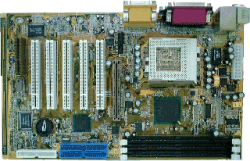 6A815E1. The board is only 190 mm wide. All connectors and slots are placed competently. On the back side the board has an insulating mount of transparent plastic - the risk of short circuit is not great, but it is still pleasant. Despite the quite good performance results, the Acorp didn't show the due stability in operation. There were some failures during the testing. Although the BIOS Setup allows controlling the FSB/SDRAM frequency, the overclocking wasn't possible since when the frequency was raised even at 1 MHz the number of failures grew. AOpen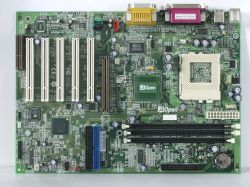 AX3S, AX3SP. The quality of AOpen's boards is growing more and more. The AX3S and AX3SP models pleased us with a convenient design and high stability. Their performance, however, is not high enough. The AX3S based on the i815E is a good board, but the AX3SP is, in my opinion, better. AOpen has equipped the board with a great deal of features. For example, apart from a standard connector WOL (Wake-on-LAN), there are WOM (Wake-on-Modem) and GPO. You can also connect an optional module Dr.LED (similar to MSI D-Led). The board has a proprietary technology called Die Hard BIOS -- two flash memory chips, one of them being reserve. The board is very beautiful. Of course, a black PCB and a silvery heatsink with a logo won't surprise anybody today, but such boards from other manufacturers cost much more. ASUS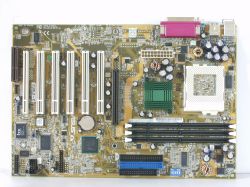 CUSL2-C. We have already written about this board. The model is intended for overclockers. But at the same time it is very efficient and reliable. We haven't included a modification of this board - CUSL2-CB ("Black Pearl") since it differs mainly in a black color. The BIOS Setup offers a wealth of fine settings including Command per cycle (Enable/Disable). The board is equipped with a proprietary monitoring chip - ASUS AS99127F. ASUS is probably the only company which doesn't use combined versions of "Super I/O + Hardware Monitor" chip. Instead, it installs two separate chips. But the CUSL2-C has far not an ideal design: IDE + FDD connectors are located too close to each other, and connectors for ATX cable and COM2 port are placed not very competently. I wish the AGP Pro slot remained on the CUSL2-C. Canyon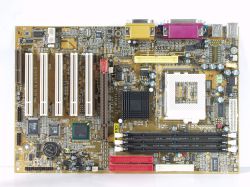 CN-65KM, CN-65KE. This manufacturer is only a beginner on the market. These boards look quite good: a neat and compact design, an AGP Pro slot, a convenient position of a connector for the second COM-port. The performance is also close to the top. Both products are meant not only for ordinary users, but also for overclockers. The BIOS Setup offers rich possibilities in adjusting a FSB/SDRAM frequency and a processor voltage. It is interesting that the BIOS Setup offers an "intellectual" auto overclocking. DFI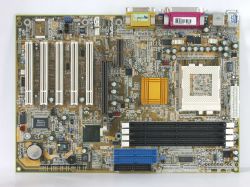 CS65-SC, CS65-EC, CS61-EC. The models differ in the chipsets and in the presence of the AC'97 codec. All boards support system monitoring of temperature, processor voltage and fan frequency. The boards can't boast of a good overclocking potential -- only the CS65-EC allows lifting the processor voltage in the BIOS Setup. The performance is rather high. The design is ordinary: a well thought-out layout of the boards with some imperfections - an unsuccessful position of an FDD-connector, a connector for the third and fourth USB-ports is placed behind the PCI slots (only in the DFI CS61-EC), it makes a haywire from the cables. Besides, an ATX connector is placed not very good except the CS65-EC model. Among the advantages, I should mark out the COM2 which is placed on a standard place for an ATX board (on the boards without integrated video). EPoX3SPA3L. This company places high emphasis on overclocking (in the number of settings in the BIOS Setup for adjustment of voltages 3SPA3L is beyond any competition - it has three of them!). But all these features are nothing without a competent layout since it ensures stability in such system. The 3SPA3L model can't, unfortunately, boast of it -- the maximum FSB/SDRAM frequency the board can work stable at is only 142 MHz. Of course, having taken advantage of the possibility to lift the voltage of the CPU, chipset and AGP, we might have obtained some more megahertz. But we have decided that all boards will participate in the overclocking test on equal terms. The board, however, looks normal as a base for a usual unoverclocked system. FastFame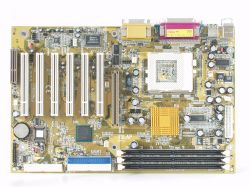 3SLAP. The board has a compact and functional design without considerable flaws (except for a CD Audio connector which you will have to pull up above an AGP video card. The board has a low performance level, the overclockability is not high either (though the BIOS Setup allows lifting the FSB frequency up to 166 MHz in 1 MHz steps). But the product costs only $78. Giga-Byte GA-6OX, GA-6OXC, GA-6OXE, GA-6OXE-1. The Giga-Byte boards are traditionally high quality and reliable. Now the company pays great attention to overclocking. The proprietary utility EasyTune is meant for auto overclocking right from the Windows. Two boards out of four are lite versions of the other ones (GA-6OXC is a lite-version of GA-6OX, GA-6OXE-1 - of GA-6OXE). The GA-6OXC has no overclocking features and is not supported by the EasyTune. The GA-6OXC is meant for tight-budget users, while the GA-6OX is for advanced users, and the GA-6OXE/GA-6OXE-1 are top models. All boards have connectors for a Smart Card Reader. Another interesting option is available only for the GA-6OXE: it is an integrated audio chip from Creative. Intel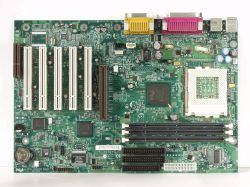 D815EEA. This board doesn't suit overclockers, but its reliability and stability are excellent. The board lacks for system monitoring, because there are no functions for overclocking. Even the RAS Precharge Time is removed from the fine memory settings in the BIOS Setup. The design of the board is average -- the IDE and FDD connectors are located close to each other, a place for an ATX connector is not the best. In order to get into the BIOS Setup with all settings you have to open the case and close one of the jumpers on the board. Iwill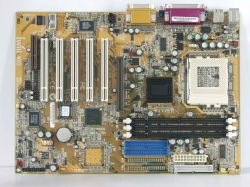 WO2. The Iwill boards are quite popular, including integrated solutions with IDE RAID or SCSI-controllers onboard. The WO2 is a "clean" solution, but it has an audio chip from CMedia (CMI 8738). There are some conveniences for assemblers: thanks to the form of jumpers you can move them without tweezers. The board has such exotic connectors as SMBus, a case opening sensor and two external thermistors. The Iwill WO2 shows high quality implementation, good stability and decent overclockability. But the model is overpriced. Maybe a board without PCI-audio would be cheaper. JetWay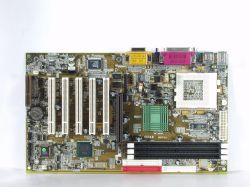 618AF. The board has a competent layout, a clamp on the AGP, and a neat and compact design. The board has taken the second place in speed. But there are some problems in the BIOS. When we set an AGP video card as master, the system refused to display an image! If you first make the system find a PCI video adapter, the AGP video card will be detected correctly. We had this problem with the ELSA Gladiac. I hope the manufacturer will correct this error in a new BIOS version. Leadtek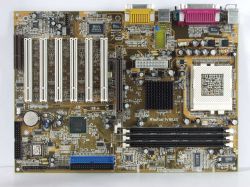 WinFast 9100AX. The board doesn't differ much from other models. The product has a good frequency generator - Realtek RTM560-25R (the FSB frequency in the BIOS Setup can be changed in 1 MHz steps from 66 to 250 MHz). You can also change Vcore. But at the standard voltage the highest FSB frequency is only 140 MHz, provided that the board works stable. The design can't be considered ideal because of the placement of FDD and ATX connectors. During the booting the Pentium III 1 GHz was detected as "Pentium III 03E8 MHz"! :) Manli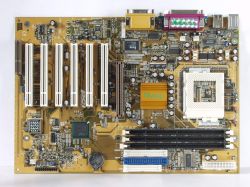 M-i815/X/370, M-i815E/X/370, M-i815EP/X/370, M-i815P/X/370. The products from this manufacturer covers the whole series of the chipsets - from i815 to i815P. These boards are rather cheap. Therefore, they often have problems with installation and adjustment. But in our case everything was Ok. The design of the whole series is not perfect (except the Manli M-i815P/X/370) - an inappropriate placement of COM2, USB 3/4 and ATX connectors. The models do not suit for overclocking - there is no system monitoring and a possibility to adjust voltages. The boards have shown perfect performance, however. But the spread in values between the boards of the same design fears me (M-i815/X/370 -- M-i815P/X/370 and M-i815E/X/370 -- M-i815EP/X/370). The characteristics may differ in different samples. I would recommend this board for business systems due to the high performance and the low price. Micro-Star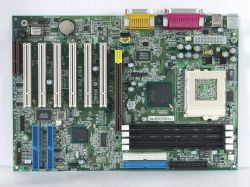 MS-6337 i815EP Pro-R. The board has left a pleasant impression due to the competent design (but for some standard flaws connected with USB- and COM-connectors). The model is equipped very well and can boast of high quality implementation. The MS-6337 i815EP Pro-R is based on the i815EP, has an additional UltraATA/100 IDE RAID controller from Promise, supports proprietary technologies D-LED and PC-to-PC and has an AGP Pro connector (which has an additional power supply connector for a video card near it). The board is equipped with a PC Speaker and 6 PCI slots. The board has a normal system monitoring (of temperature, fan frequency, voltage). You can also change processor and chipset voltages. The FSB frequency can be changed within the range from 100 to 166 MHz. But the overclocking results are very low. On the whole, the board is a very good, high quality product. The board is not cheap, but offers a lot of additional functions. PC Partner 815AS3-960C, 815EAS3-978C. The boards have a good price/performance ratio. The stability is also excellent. But the design is far from being ideal - IDE and FDD connectors are too close to each other, an ATX cable prevents access to DIMMs. At the same time, the board has some free space. I would recommend this board for business machines. Shuttle AE22, AE23. The AE23 yields to the AE22 in performance. It can be explained only by problems in the BIOS. The AE22 uses the BIOS from AMI (in the AE23 it is from AWARD). The AGP slot on both boards covers all three DIMMs. A placement of the COM2 and 3/4 USB connectors is unsuccessful as well. The model has hardware monitoring: everything from processor voltage to a fan speed is controlled. But the board doesn't permits adjusting voltages. The AE23 has a better performance - it is right in the middle of the table, in all other respects the board follows its predecessor - AE22. The AE22 has shown high overclocking results. I think that such a record frequency is explained by its low efficiency. Most likely, some settings in the BIOS are reduced in order to make the board stable. Soltek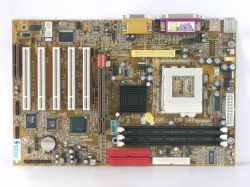 SL-65ME+, SL-65EP. Both boards are based on a PCB of the same design, differing only in the chipset. The SL-65ME+ is equipped with integrated video. Apart from a standard VGA-connector, there is a connector for an external encoder for displaying images on TFT panels. The performance of both boards is better than just average, the SL-65ME+ has taken the fourth place in the Dragon NaturallySpeaking test. In overclocking the boards do not excel. The price of both models is, however, much lower than that of the champions in overclocking. Soyo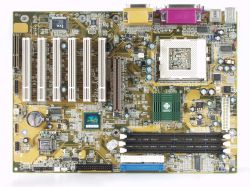 SY-7IS2, SY-7ISA+. Both boards have shown good results in all tests. And in the performance the Soyo SY-7ISA+ has taken the second place after the ASUS CUSL2-C in the Dragon NaturallySpeaking 4.0. It is unclear what group of users the product is intended for. The SY-7IS2 board overclocks rather good, but there are not enough possibilities to adjust settings in the BIOS Setup. On the other hand, the board is not cheap. Nevertheless, it lack for some salt. I can see that the model is not bad on the whole, but I don't understand who it is meant for. Transcend TS-ASL3, TS-ASP3. The TS-ASL3 is competent, almost ideal as far as design is concerned. The TS-ASP3 is based on an identical PCB and differs only in a chipset (and lack of integrated video). Both boards are in the middle of the rating in speed, and among the first top models in overclockability. It means that Transcend takes seriously production of their boards. Tyan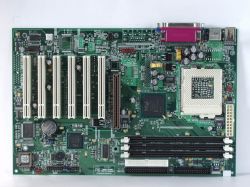 Tomcat i815e (S2060). As a rule, this company produces boards for powerful workstations or servers. Such a serious approach gives us a right to expect the respective results from the Tomcat i815e. The design is almost ideal, except the placement of an FDD connector. But the high reliability means not a high performance, like in case of Intel. The board, however, lags behind the leader in speed by not more than 5%. Overclocking possibilities of the Tomcat i815e are absent. Results   ConclusionThe best board for overclocking is the ASUS CUSL2-C. It is followed by the AOpen AX3SP. This decision was not easy because it is a bit easier to overclock the AOpen AX3SP, but overclocking is not valuable itself, it is only a free way of gaining the performance, and in this respect the AOpen AX3SP loses to the ASUS. The third place is taken by the Giga-Byte GA-6OXE-1. This board easily overclocks and costs not much. The Transcend TS-ASP3 falls behind it by a little margin, but the i815E chipset with integrated graphics doesn't correspond to an image of an overclockable board. Now let's leave overclocking aside. The best board for assembling of ordinary computers is the Giga-Byte GA-6OXE. It is equipped with an excellent set of additional functions (normal PCI sound, a Smart Card connector), perfect expandability (4 DIMM, 6 PCI) and Dual BIOS. The second place is taken by the Transcend TS-ASL3: a reliable, stable, with a good layout board. The third place is given to the Canyon CN-65KE. The board has a rich complete set and good documentation. The board itself is a high quality product. Besides, it has an optimal price. Apart from the abovementioned, I also want to mark
out the Micro-Star's solution, both boards from Soltek and a model
of FastFame. The 3SLAP has a very attractive price.
Write a comment below. No registration needed!
|
Platform · Video · Multimedia · Mobile · Other || About us & Privacy policy · Twitter · Facebook Copyright © Byrds Research & Publishing, Ltd., 1997–2011. All rights reserved. |